{english below} SK8FACE es un documental sobre la historia y la evolución del arte y de la cultura del monopatín. El aclamado director Matt Bass nos adentra en un viaje en el tiempo que permite entender por qué una simple tabla de madera con ruedas de patines ha acabado convirtiéndose en un icono cultural que se expone en museos de todo el mundo. Un recorrido que empieza en la década de los 50 con los verdaderos pioneros y que termina en la actualidad, cuando las tablas de skate se consideran obras de arte. Una mirada fascinante a cómo el skate ha creado su propia subcultura, al mismo tiempo que ha influenciado a la cultura popular y a los medios de comunicación de masas. El documental cuenta con la participación de leyendas del patín que explican en primera persona sus experiencias y por qué siguen atrapados en este mundo de colores y asfalto. Además, existe una conexión más que evidente entre los gráficos de las tablas y su influencia en la escena artística contemporánea que se ha forjado gracias a la filosofía del Do It Yourself. Entre los participantes más relevantes encontramos a Mark Gonzales, Natas Kaupas, Tony Hawk, VCJ, Jim Phillips, Shepard Fairey, Ed Templeton y Eli Morgan Gesner.
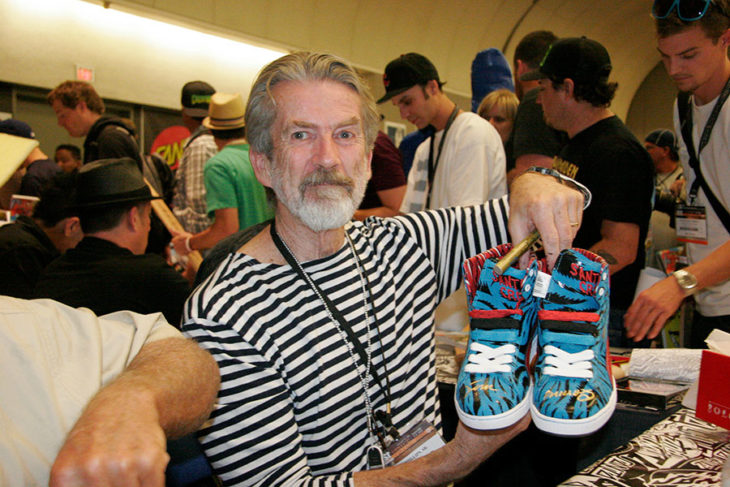
Hablanos un poco de ti Matt, de tu pasion por el cine, de la cultura de donde provienes, etc…
Nací en el Bronx y crecí en los suburbios de NYC en un pueblo llamado Spring Valley, en los años 80. A principios de los 80 el skateboarding era bastante underground y en la costa este estaba prácticamente extinguido, yo tenía una tabla de plástico de mierda cuando era pequeño, alrededor de los 6 o 7 años, pero no fue hasta mediados de los 80 que supe lo que era un skate de verdad. En realidad, fue a través del BMX que descubrí el skateboarding, fue en BMX Action o Freestylin donde vi por primera vez a los skaters montando en piscinas y mi mente explotó. No fue mucho después de eso que conseguí mi primer monopatín de verdad que no era exactamente de nivel profesional, era un Variflex Hi Tail y lo conseguí en el local Caldor (que es como un walmart). Cuando era joven mi padre enseñaba fotografía en un instituto del Bronx, siempre tenía cámaras alrededor, incluso tenía un cuarto oscuro que construyó en el sótano de nuestra casa. Esto me pareció algo normal, así que empecé a hacer fotos y a revelarlas en la escuela primaria. No me lo tomaba en serio, era algo que hacía con mi padre y era divertido. De niño pensaba que el cuarto oscuro era un lugar mágico donde las fotos aparecían de la nada, de hecho, todavía me desconcierta. Con el tiempo, mi padre amplió sus conocimientos de fotografía y puso en marcha un negocio de fotografía de bodas que básicamente se convirtió en el negocio familiar, mi madre era la directora del estudio y no tardé mucho en ser contratado para trabajar, tenía unos 14 años en ese momento. Mirando hacia atrás, fue la columna vertebral de mi futura carrera, porque tuve la repetición de usar cámaras y equipos profesionales y aprendí pronto que trabajar largas jornadas era sólo una parte del proceso.
Aprendí a cargar las cámaras de película, a montar las luces, a cargar con equipos pesados, a hacer paradas, a la velocidad de la película y, lo que es más importante, a ser intuitivo con el entorno para estar siempre en el lugar adecuado en el momento adecuado; en esencia, estaba en la escuela de fotografía, pero no prestaba mucha atención a los detalles, como cualquier adolescente, sólo hacía el trabajo por el trabajo, y me costó años de repetición hasta que todo empezó a tener sentido. La mejor parte que pensé en ese momento fue simplemente ganar dinero para poder mantener mi nueva adicción, ¡el skate!
Simultáneamente estaba obsesionado con la lectura de Transworld, Thrasher y Freestylin. Las imágenes de Grant Britain, Bryce Kanights y Bob Osborne me parecían de otro nivel. Desenfocaban las imágenes, disparaban flashes y hacían fotos con objetivos muy amplios. Toda esta estética era completamente opuesta al trabajo que hacía el fin de semana con mi padre, así que había un equilibrio entre aprender a ejecutar las cosas técnicamente y la inspiración de romper esas reglas e ir a otro lugar. También me encantaba el diseño que David Carson hacía para la TWS, era tan diferente de lo que se veía en cualquier otro sitio, era tan creativo y siempre cambiaba, como lo hacía el skateboarding en aquella época. Siempre me entusiasmaba recibir una nueva revista, no sólo para ver los últimos trucos y patinadores, sino para ver lo radicales que eran las fotos y los diseños. Tuvo un profundo impacto en mi forma de percibir el mundo y de interpretar el arte. También me hizo darme cuenta de que la mayor parte del mundo impreso funcionaba con una estética “normal” y que estas revistas de skate iban claramente a contracorriente. Todo esto tenía sentido para mí y me metí de lleno en la cultura del skate y se convirtió en parte de mi identidad, sobre todo desde que era un adolescente.
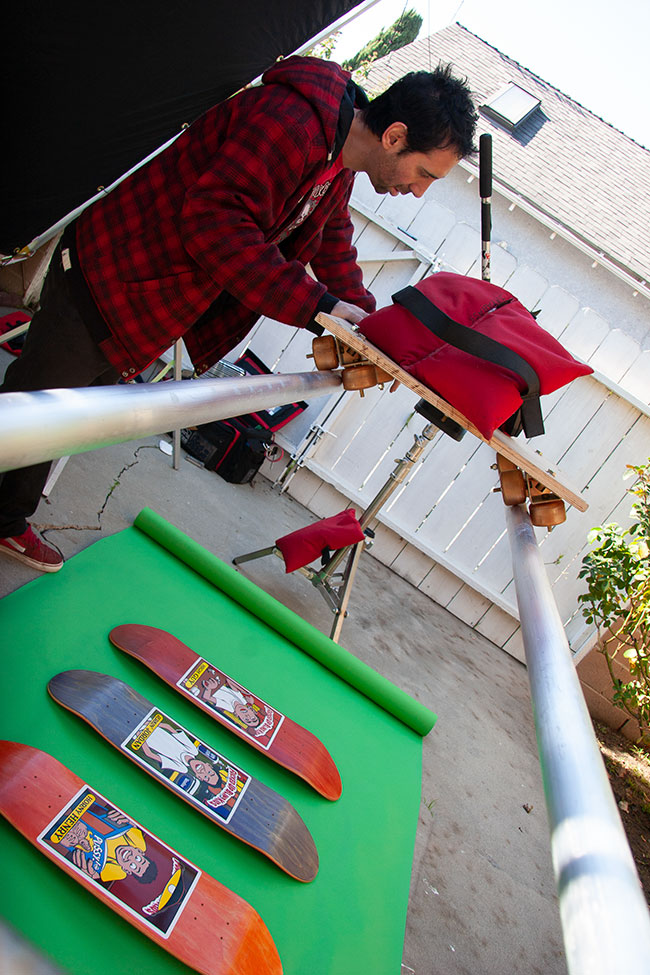
Sk8face es la película definitiva sobre el arte gráfico en el skate. ¿Cómo llegaste a esta historia?
Dirigía y rodaba vídeos musicales a principios de la década de 2000 y me di cuenta de que tenía que hacer un largometraje o me quedaría haciendo vídeos musicales de death metal para siempre. Ya había trabajado en algunos documentales como director de fotografía, así que pensé que podría hacer algo con mis limitados recursos. Por aquel entonces salió el libro de Sean Cliver, Disposable, y me metí de lleno en él, lo leí como un viejo Thrasher, una y otra vez hasta que se me cayeron las páginas. Siempre me había gustado el arte del monopatín, pero este libro me abrió las historias de cómo se desarrolló todo. Yo era un poco un acaparador de cubiertas de skate en ese momento, había guardado algunas cubiertas viejas mías de BITD e incluso tenía una Vision Gonz NOS que había encontrado en el 95 por 45 dólares, todo esto estaba empezando a encajar para mí y finalmente me di cuenta de que nadie había hecho una película sobre el arte del skate. Realmente no podía creerlo, ¿cómo es posible que nadie haya hecho una película sobre el arte del monopatín? ¡¡¡¡Ha existido durante décadas!!!!
Así que empecé a esbozar el concepto y a planear cómo carajo iba a sacar esto adelante sin dinero.
Al igual que en el caso del monopatín, me lancé y empecé a empujar. No sabía que iba a ser el mayor proyecto de mi vida y que me llevaría más de 13 años y toneladas de mi propio dinero para llevarlo a cabo, en cierto sentido es el mayor truco de skate que podría haber hecho (risas).

¿Cuáles fueron los momentos más difíciles de hacer la película?
Los momentos más difíciles de hacer la película fueron el montaje. El rodaje es la parte más divertida, conoces a tus héroes y te enteras de sus historias personales, pero luego tienes que revisarlo todo y hacer que tenga sentido. Parece sencillo, pero no lo es ni de lejos. Aprendí muy pronto que no podía editar esta película, estaba literalmente enamorado de todo, así que necesitaba el editor adecuado para unirlo todo. El editor original era uno de mis amigos más antiguos y también creo el tráiler que se convirtió en viral, ¡un saludo a Ron Haas!. Ron cortó la película durante los dos primeros años, pero al final nos quedamos sin el poco dinero que habíamos conseguido y todos sabemos que si no hay dinero es muy difícil crear cosas, así que no funcionó. Fue duro trabajar en una película de muy bajo presupuesto, incluso dejé la película durante un año o así porque todo el asunto era deprimente.
No voy a mentir, a lo largo de los años he querido tirar mi disco duro desde un edificio y darlo por terminado, como cuando tiras la tabla cuando fallas un truco, pero, por supuesto, nunca lo hice, sino que seguí adelante. Al final descubrí que mi amigo Eric Pritchard, al que conocí trabajando en el primer pase de la película, era el editor perfecto, porque era un auténtico fanático del skate que conocía toda la historia. Para mí fue un gran acontecimiento, porque ya es bastante difícil montar un documental, pero si no conoces la historia del monopatín también tienes que aprenderla. Eric era el hombre perfecto para el trabajo y resultó ser el hermano de Mark Gonzales.
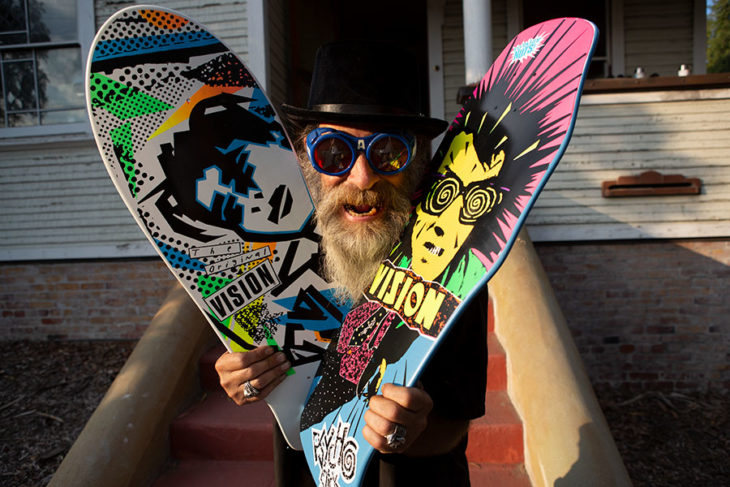
¿Qué aprendiste en el proceso en todos estos años o meses haciendo este documental?
¡Muchísimas cosas!. Hacer una película se parece mucho al skateboarding, ya que nunca dejas de aprender nuevos trucos. He aprendido que hay que ser pacientemente persistente para que las cosas den sus frutos. Por ejemplo, me llevó tres años conseguir finalmente a Ed Templeton, la mayoría de la gente se habría rendido, pero yo sabía que tenía que estar en la película, así que seguí presionando para conseguirlo hasta que lo conseguí. Esa es sólo una de las muchas historias de este tipo. También aprendí que hacer películas, incluso si se trata de un documental, va a costar mucho dinero, no hay manera de evitarlo. Ya sea por los discos duros, las comidas del equipo, la música, los ordenadores, las cámaras, las luces, más discos duros, los abogados, los costes de la empresa, la edición, mucha edición, etc… es interminable.
Estoy muy contento de haber elegido hacer una película sobre algo que me gusta, porque es mejor que ames el proyecto en el que trabajas, porque esa es la columna vertebral y el alma del proceso. Hacer películas es un proceso lento, hay muchas piezas en el rompecabezas y el rompecabezas es enorme, pero es ese tipo de desafío el que realmente me gusta.
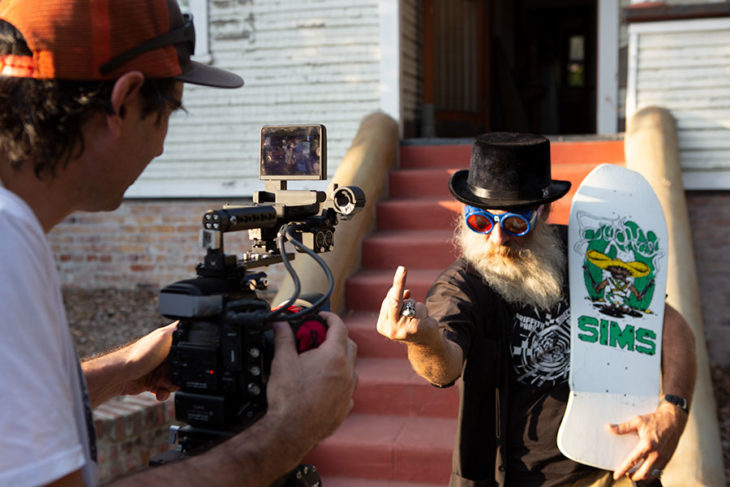
¿Qué impacto crees que ha tenido el arte gráfico del skate en la cultura pop?
Hay alguna década específica en la que el skate gráfico tuvo más impacto en la cultura pop, como quizás los 60 con toda la cultura del surf-rock, o quizás los 70 con todo el hippie y más tarde el punk, Tony Alva… , o los 80 con Powell Peralta, Santa Cruz, Natas, VC Johson, Jim Phillips, etc…
Es realmente difícil calibrar qué imágenes o gráficos tuvieron más impacto en la cultura en su conjunto. En el caso de los patinadores, es fácil identificarlo porque siempre hemos tenido un patinador favorito cuyo arte lo apoyaba. Si nos remontamos a la época de Dogtown, yo diría que fue la que más impacto tuvo, porque fue un punto de inflexión en el que el skateboarding pasó de ser algo cursi a ser algo malo. Fue la tormenta perfecta de trucos de skate, los infames gráficos de las tablas de Dogtown de Wes Humpston, CR Steyck y Glen E Friedman haciendo fotos, el patinaje en la piscina y el estilo “fuck it up” de Jay Adams y, por supuesto, el Punk Rock.
El skateboarding nunca fue lo mismo después de eso y puedes ver esa actitud todavía vibrando bajo tus pies. Esta no era la época en la que crecí practicando el skateboarding, pero a medida que fui creciendo me fui informando de cómo se desarrollaban las cosas realmente. Yo era más bien un skater de los años 80. Así que Santa Cruz, Powell y Vision eran más de mi época. Crecí con los diseños que haciamos en la lija. El comienzo del patinaje de calle que se llamaba Street Style al principio, y la explosión del arte del monopatín de los 80 que me inspiró íntimamente para hacer esta película. Me atrajeron tipos como Neil Blender y Gonz, no sólo por su singular forma de patinar, sino por su arte de flujo libre, que parecía ser el reflejo perfecto de sus personalidades.
VC Johnson y Jim Phillips también me dejaron boquiabierto, me impresionó mucho que las empresas de monopatines contrataran realmente a artistas adecuados para hacer gráficos, porque todo lo que conocía antes eran tablas de tiendas de juguetes con logotipos o malos gráficos. El estilo místico de VC era inquietante y la ejecución de Jim Phillips era simplemente increíble. ¡¡¡El Roskopp 3 era como mi tercera baraja y recuerdo que miraba fijamente ese tablero y me preguntaba qué iba a ser el próximo Roskopp!!!
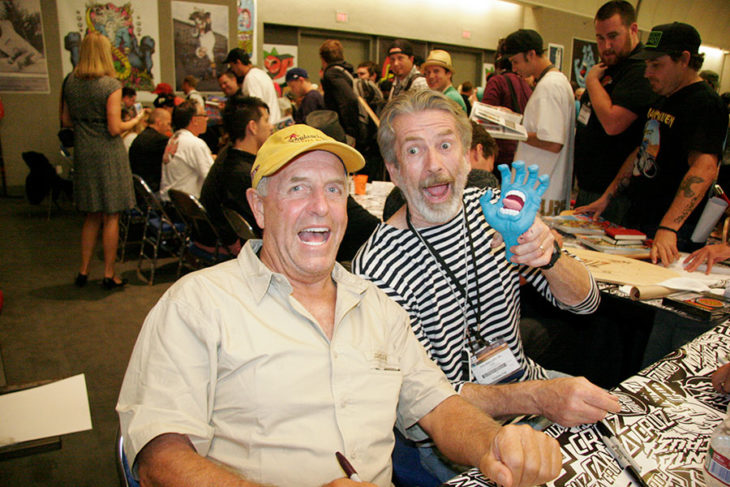
¿Y como ves la gran explosion del arte en los 90 con Jason Lee, Jonze, Ed Templeton, Gonzales….?
Los 90 fueron una época tan divertida en cuanto a gráficos de skate, todo el mundo decía “a la mierda” ¡quién nos va a parar! Conocía a Spike por la revista Freestylin Mag, donde era uno de los fotógrafos principales, así que cuando empezó con Girl me alegré de que liderara ese cambio. Lo mismo me pasó con Blind cuando Gonz empezó, me alegré mucho de ver a todos estos skaters profesionales dejando las grandes compañías y empezando cosas nuevas. El skateboarding también estaba en crisis en esa época. Recuerdo que cuando estaba en la SVA en Nueva York a principios de los 90 apenas había skaters en toda la ciudad, volvía a ser underground en cierto modo, especialmente en la costa este. Ver a Ed Templeton iniciar Toy Machine y a Jason Lee hacer Stereo con Chris Pastras fue igualmente radical. Esta mentalidad de “podemos hacerlo” se convirtió en parte de mi ADN. Estos chicos fueron mi fuente de inspiración más allá del monopatín, pero como pioneros de los negocios.
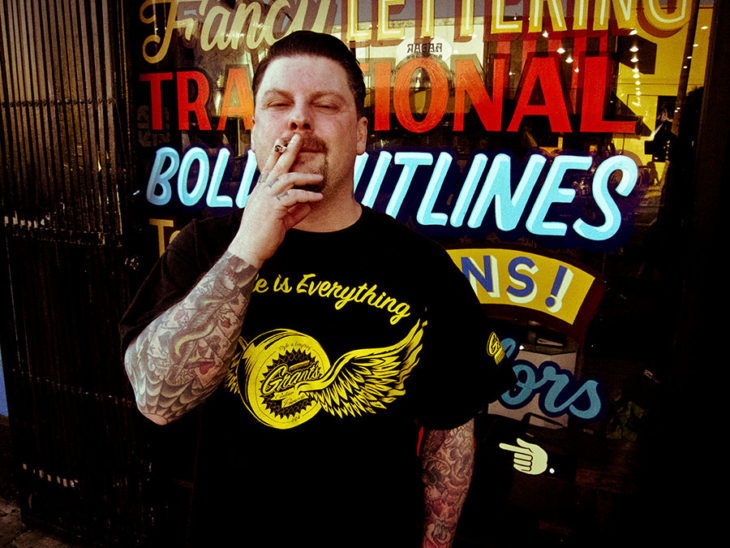
Podemos decir sin pestañear que Gonz es el skater con más impacto en la cultura pop, pero ¿Crees que es el más importante en la industria del skate en sí o quizás más Jim Phillips, VC Johnson…?
La cultura pop…, es un término gracioso en realidad. Lo que es realmente divertido es pensar en cómo el skateboarding es ahora la cultura pop cuando en su dia era una cosa subterránea que jodía a lo establecido, lo hacías porque lo amabas no porque pensabas que podías conseguir un patrocinador de bebidas energéticas e ir a las Olimpiadas. Con el tiempo, evolucionó hasta convertirse en lo que es hoy porque todos los chicos que crecieron amando estas cosas acabaron consiguiendo trabajo y utilizaron esa inspiración como columna vertebral. Pero si realmente quieres una identificación con la cultura pop, tendría que decir que una de las imágenes más reconocibles que ha surgido del monopatín es la Mano Gritona de Jim Phillips. Está en todas partes y la gente que no patina conoce esa imagen. Para mí se remonta a Mark Gonzales porque es el primer patinador profesional que vi patinar. Lo que realmente me gustaba de Gonz era su estilo artístico de flujo libre, que no era exactamente de nivel profesional, sino más bien de bricolaje. No podía dibujar como VCJ o Jim Phillips, pero podía expresarme con marcadores de pintura como Gonz.

¿Qué periodo del skate art crees que ha sido el más importante para el mundo del skate?
Cada generación va a tener una conexión especial con las tablas y los gráficos de la época en la que crecieron. Cada época tiene sus propios artistas rompedores, pero realmente cambió con Dogtown y Wes Humpston. Él fue el primero en hacer gráficos a todo color y dibujados a mano, y esto sigue siendo relevante hoy en día. Para mí, el periodo más importante es cuando los patinadores profesionales empezaron a hacer sus propios gráficos, lo que supuso un gran cambio y modificó todo el panorama de la industria. Había gente como Chris Miller haciendo Planet Earth y Gonz haciendo Blind, y como patinador te entusiasmaba ver a tus patinadores favoritos crear sus propias empresas. Esto nos mostró que podemos hacer lo mismo en la vida, simplemente como bricolaje.
También me encantan las tablas de los 90. Todos esos divertidos gráficos falsos de Marc Mckee y Cliver son brillantes, simplemente lo llevaban tan lejos como podían y no les importaban una mierda las consecuencias. Marc y Sean son posiblemente algunos de los mejores artistas del skateboarding. Las mierdas que hacían entonces no las podrías hacer ahora o te meterian en la carcel, jajaja.
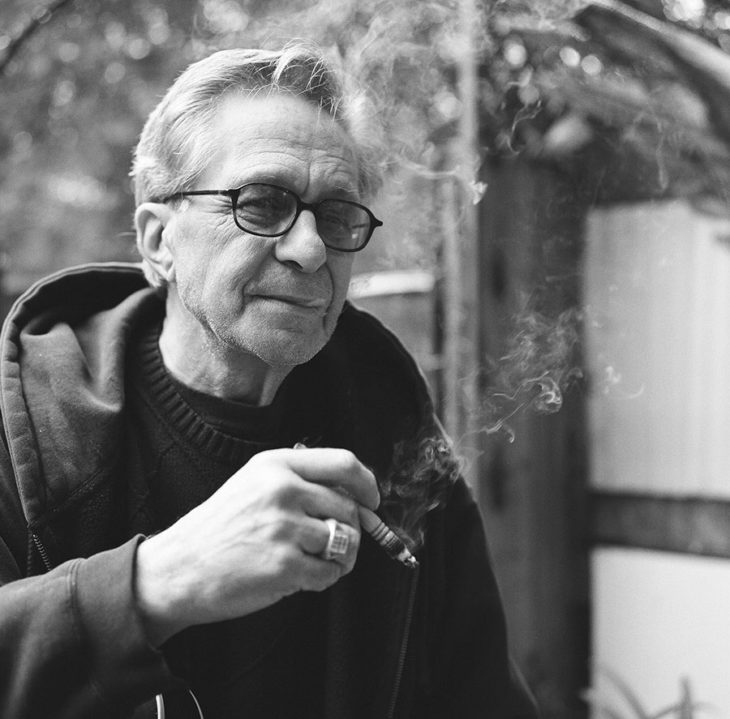
¿Qué opinas de todo el revival y el negocio que se ha montado alrededor de las tablas antiguas, y como ya se están reeditando todas las tablas de los 80, y se reeditan pensando en ediciones limitadas, Ebay…?
Ahora que el skateboarding está en todas partes, las reediciones han adquirido un significado totalmente distinto. Ahora los niños pueden ir a comprar una reedición de Alva o Powell porque quieren la sensación de esa época o simplemente les gusta el arte. Muchos coleccionistas odian las reediciones, pero para la gente que realmente las patina es una forma de revivir una época del pasado. Personalmente, no compraré una reedición a menos que esté serigrafiada, tengo unas cuantas en la colección y es una forma de coleccionar tus tablas favoritas, pero sin tener que desembolsar mucho dinero por una cubierta. Lo que es una locura es ver tablas reeditadas vendidas por cientos de dólares, eso no lo entiendo, pero supongo que hay coleccionistas por ahí que deben tenerla sin importar el costo.
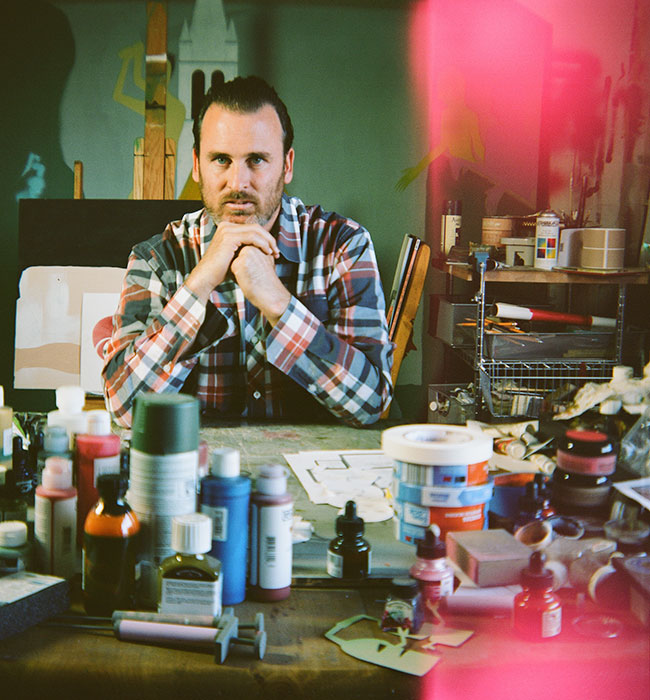
Siendo una película tan importante, ¿por qué no decidiste buscar el apoyo de una marca de skate, como Vans, por ejemplo?
Hubo un tiempo, al principio de hacer la película me acerqué a algunas marcas, pero esto fue antes de Instagram y las redes sociales, estas grandes marcas estaban todas en hacer porno de skate para vender tablas de skate y no videos de arte.
Mira, si Vans, Es, Santa Cruz, Powell o cualquier otra compañía de skate grande o pequeña quiere ser parte de la película, estoy abierto a ello. Personalmente me encantaría tener a Vans como patrocinador, ya que han pasado por todas las décadas que representa esta película y siguen siendo relevantes hoy en día, no hay muchas empresas que lleven tanto tiempo.
La paradoja de esta película es que no puede ser una película traída por la “Company X” del monopatín porque es una película sobre TODAS estas compañías, así que en mi mente sería ideal si todas ellas contribuyeran a la película.
Debajo de todo este proyecto hay una mentalidad de bricolaje. Mi cerebro de skater ochentero cree que puedo hacerlo todo yo mismo y por eso ha tardado tanto en terminarse, porque he sido yo quien ha empujado este monstruo colina arriba, no sólo metafóricamente, sino también financieramente.
Hubo un momento en el que una importante bebida energética quiso darme dinero para la película y, al final, decidí que no, porque desprecio las bebidas energéticas y el veneno que realmente son. Pasé 5 años trabajando con Danny Way, Bob Burnquest y Frank Scura en la promoción de A.S.E.C. (action sports environmental coalition), que instruía a los niños sobre cómo comer sano y cuidarse. Siempre admiré a Danny y a Bob por su forma de patinar, pero una vez que vi lo apasionados que eran estos chicos por su labor, sentí un nuevo respeto por ellos. Bob y Danny nunca aceptaron ese tipo de patrocinio, tomaron alternativas saludables como el Acai y la Yerba Mate, porque son verdaderos atletas y tienen una brújula moral que no se limita a la ganancia financiera, sino que va más allá. Por otro lado, me alegro de que los patinadores puedan vivir de los patrocinadores corporativos, pero realmente me gustaría que estas empresas de bebidas cambiaran sus ingredientes para beneficiar realmente a los patinadores.
SK8FACE es básicamente mi carta de amor al skateboarding, por todas las cosas alucinantes que he aprendido del skateboarding fue la perseverancia de ser un skater y aprender un nuevo truco sin importar lo difícil o peligroso que fuera o cuántas veces te destrozaras, todavía te levantaste y seguiste empujando para lograr el truco sin importar qué. A veces tienes suerte y consigues un truco nuevo en unos pocos intentos y otras veces tardas años hasta que finalmente consigues ese Ollie Impossible.

¿Cuáles son los proyectos futuros en los que estás trabajando?
Me gustaría hacer otro documental en algún momento, algo más centrado en un individuo y más íntimo. La razón por la que nadie ha hecho una película sobre el arte del monopatín hasta ahora es porque habría que estar loco para intentar abordar un documental que abarca más de 70 años y que sigue expandiéndose.
Actualmente, mis otros proyectos son trabajar como director de fotografía en un documental de HBO, rodar anuncios publicitarios y dirigir LOST LA, que es un programa social de la PBS sobre historias históricas de Los Ángeles. Supongo que, de una manera divertida, mi pasión por la historia del skate se ha transformado en una especie de documentalista histórico, lo que es un sueño hecho realidad.
www.sk8face.com
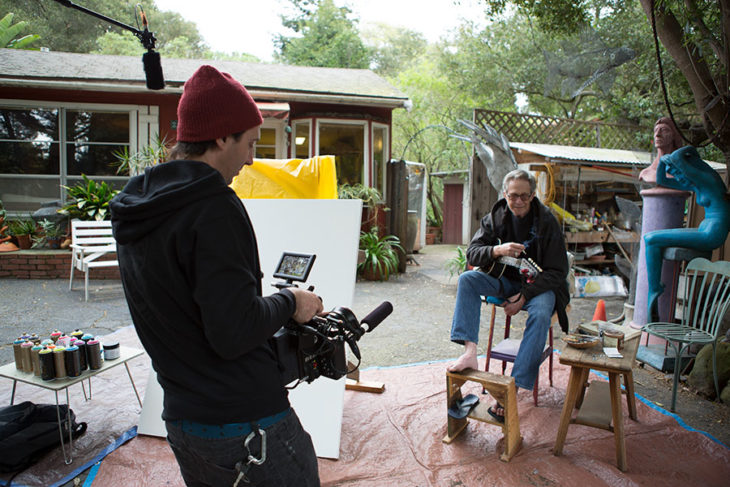
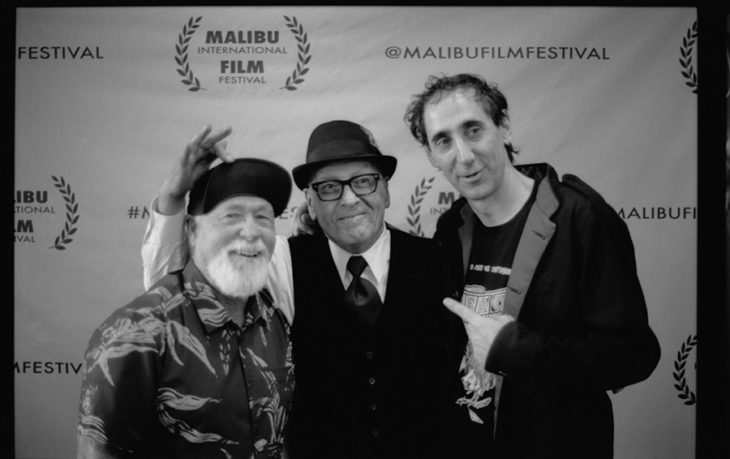
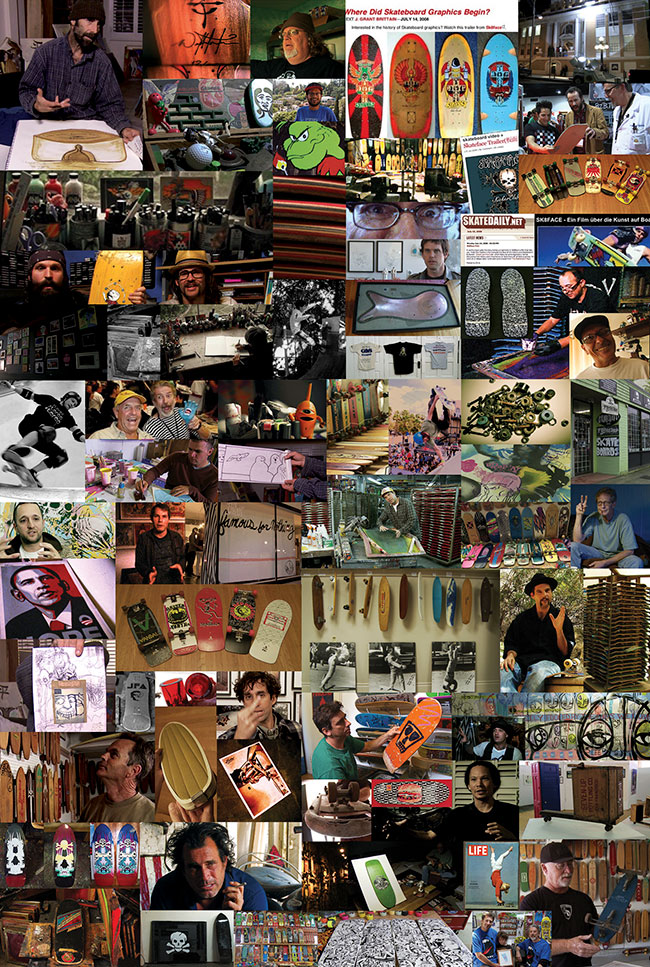
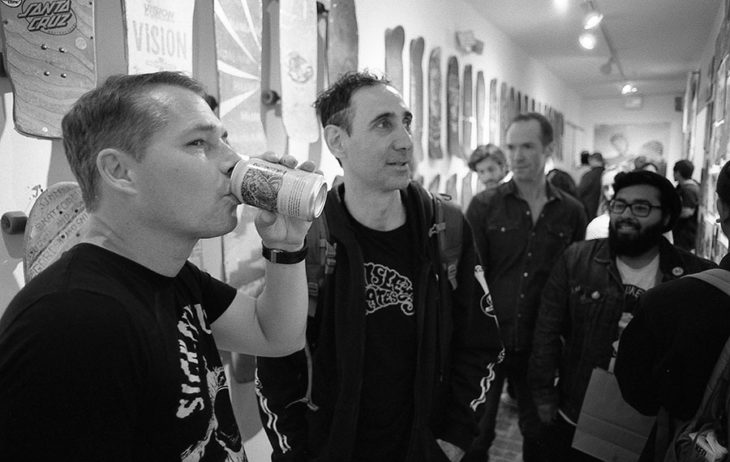
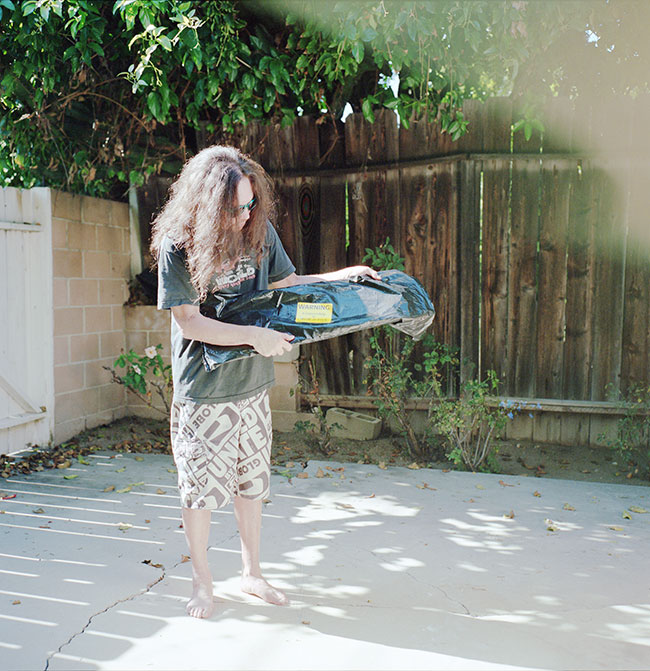
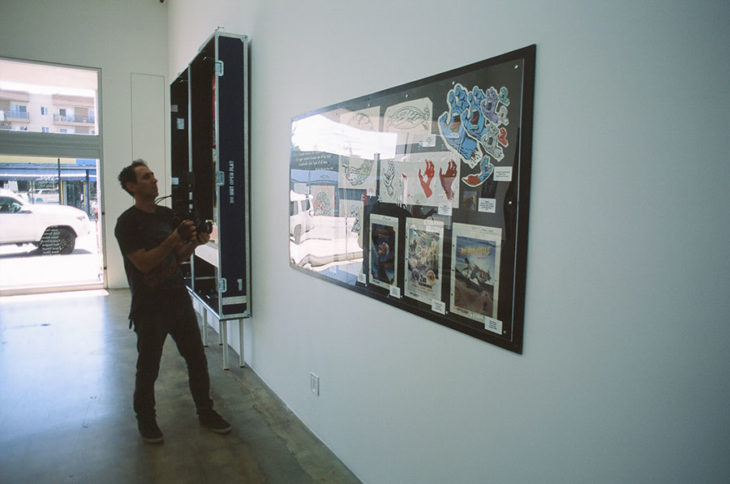
English:
SK8FACE.
THE EVOLUTION OF SKATEBOARD ART
Matt, what you like to do in personal life, how was into cinema…, tell us also about the culture where you come from.
I was born in the Bronx and grew up in the suburbs of NYC in a town called Spring Valley, in the 1980’s. In the early 80’s skateboarding was pretty underground and on the east coast it was practically extinct, I did have shitty plastic board as young kid around 6 or 7 but it wasn’t until the mid 80’s did I even know what a real skateboard was. It was actually through BMX that I discovered skateboarding, it was BMX Action or Freestylin where I first saw skateboarders riding pools and my mind exploded. It wasn’t long after that that I got my first proper skateboard which wasn’t exactly pro level, it was a Variflex Hi Tail and I got it the local Caldor (which is like a walmart). When I was young my Dad taught photography in a Bronx High School, he always had cameras around, he even had a darkroom he built in the basement of our house. This seemed like a normal thing for me so I started taking photos and developing them in elementary school. I didn’t really take it seriously it was just something to do with my Dad and it was fun. As a kid I really thought the Dark Room was this magical place where pictures would appear out of thin air, in fact it still mystifies me today. Eventually my Dad expanded his photography skills and started a Wedding photo business which basically became the family business, my Mom was the studio manager and so it wasn’t before long that I was recruited to work, I was about 14 at this time. Looking back on it was the backbone of my future career, because I had the repetition of using professional cameras and gear and learned early on working long days was just apart of the process.
I learned to load film cameras, set up lights, lug around heavy gear, stops, film speed and most importably to be intuitive to your surroundings so that you are always in the right place at the right time, essentially, I was in photography school but I didn’t really pay that much attention to the details, like any teenager I was just doing the work for works sake, it took years of repetition until it all started making sense. The best part I thought at the time was simply making money so I can support my new addiction, skateboarding!
Simultaneously I was obsessed with reading Transworld, Thrasher and Freestylin. I thought the images of Grant Britain, Bryce Kanights, and Bob Osborne were just on a whole other level. They were blurring images and popping flashes and shooting with crazy wide lenses. This whole aesthetic was the complete opposite of the work I was doing on the weekend with my Dad, so there was the balance of learning how to execute things technically but then there was this inspiration of how to break those rules and go to another place. I also really loved the layout stuff David Carson was doing back then for TWS, it was so different then what you would see anywhere else, it was so creative and always changing just like skateboarding was back then. I was always so exited to get a new mag, not just to see the latest tricks and skaters but to see how rad the pics and layouts were. It really had a profound impact on how I perceived the world and interpreted art. It also made me realize that most of the print world was operating on a “normal” aesthetic and these skate mags were clearly going against that grain. This all just made sense to me and I went full on into skate culture and it became apart of my identity, especially since I was just a teenager.
Sk8face is the definite film about art-graphics in skateboarding. How did you came to this story?
I was Directing and Shooting music videos in the early 2000’s and realized I needed to make a feature film or I would be making death metal music videos forever. I had worked on a few documentaries as a cinematographer by this point so I figured I could probably make something with my limited resources. It was around this time Sean Cliver’s book Disposable came out and I just went full on into this book, I read it like an old Thrasher, over and over and over and over again until the pages fell out. I had always loved skateboard art but this book opened up the stories of how it all developed. I was a bit of a skate deck hoarder at that point, I had kept few old decks of mine from BITD and even had an NOS Vision Gonz I had found in 95 for $45, all of it was starting to click for me and finally realized that nobody had made a film about skateboard art. I really couldn’t believe it, like how could nobody have made a movie about skateboard art? It´s been around for decades!!!!
So, I started outlining the concept and plotting how the fuck I was going to pull this off with no money.
Much like skateboarding I just jumped on and started pushing. Little did I know it was going to be the biggest project of my life and take over 13 years and tons of my own money to get through it, in a sense it´s the biggest skate trick I could ever have done, lol.
What was the hardest moments in making the film?
The hardest moments of making the film was the Editing. Filming is the super fun part, you get to meet your heroes and learn all about their personal stories, but then you have to go through all of it and have it all make sense! Sounds simple but it´s not even close. I learned very early on there is no way I could edit this movie, I was literally in love with everything so I needed the right editor to stitch it all together. The original editor was one of my oldest friends and he also cut the trailer that went Viral, shout out to Ron Haas!. Ron cut the film for the first couple of years but eventually we ran out of what little money we raised and we all know with no cash flowing it´s very difficult to create things, so that didn’t quite work out. It was tough working on a super low- no budget movie, I even put the movie down for a year or so because the whole thing was depressing.
I´m not going to lie there was a few times over the years I wanted to throw my Harddrive off a building and call it a day, kinda like how you throw your board when you miss a trick, but of course I never did that, I just kept pushing. I eventually had the revelation that my friend Eric Pritchard who I had met through working on the first pass on the movie was the perfect editor because he was indeed a skate nerd who knew all of the history. This was huge deal for me, because it´s hard enough to cut together a documentary but if you don’t know skateboard history you would have to learn that too!
Eric was the perfect man for the job and he happened to be the brother of Mark Gonzales.
What you learned in the process all these years or months doing the film?
Soooooo many things!!!!. Filmmaking is a lot like skateboarding in that you never stop learning new tricks. I have learned you need to be patiently persistent for things to pay off. For example, It took me three years to finally lock in Ed Templeton, most people would have given up, but I knew he needed to be in the movie so I kept pushing to get him until did. That´s just one of many stories like that. I also learned that making movies even if it´s a documentary is going to cost lots of money, there is just no way around it. Whether its hard drives, meals for the crew, music, computers, cameras, lights, more hardrives, lawyers, LLC costs, editing, lots of editing, etc…its endless.
I´m really glad I chose to make a film about something I love because you better love the project your working on because that´s the backbone and soul to the process. Making movies is just a slow process, there are so many pieces to the puzzle and the puzzle is enormous, but it´s that kind of challenge I really love.
What impact you think skate art graphics had in the pop culture?
Is any specific decade skate graphic had more impact in pop culture, like maybe the 60s with all the surf-rock culture, or maybe the 70s with all the hippie and later punk, Tony Alva… , or 80s with Powell Peralta,Santa Cruz, Natas, VC Johson, Jim Phillips, etc…
It´s really difficult to gauge what images or graphics had the most impact on culture as a whole. For skaters it´s easy to identify because we always had a favorite skater whose art supported that. If you go back to the Dogtown days I would say that probably had the most impact because that was a distinct turning point when skateboarding was kinda cheesy to being badass. That was the perfect storm of skateboard tricks, the infamous Wes Humpston Dogtown DIY board graphics, CR Steyck and Glen E Friedman taking pics, pool skating and Jay Adams fuck it up style and of course Punk Rock.
Skateboarding was never the same after that and you can see that attitude still vibrating under your feet. This wasn’t the Era I grew up skateboarding in but as I got older I was educated on how stuff really developed. I was more of an 80’s kid skater. So, Santa Cruz, Powell and Vision were more of my time frame. I grew up with paint markers and grip tape art, the beginning of street skating which was called Street Style at first, and the explosion of the 80s skateboard art that intimately inspirited me to make this film. It was guys like Neil Blender and Gonz that I gravitated to, not just for their unique skateboarding but because of their free flow art that seemed to be the perfect reflection of their personalities. VC Johnson and Jim Phillips also blew my mind, I was so impressed that skateboard companies actually hired proper artists to make graphics, because all I knew before was toy store boards with logos or bad graphics. The mystical style of VC was haunting and the execution of Jim Phillips was simply amazing. The Roskopp 3 was like my 3rd deck and I remember staring at that board and wondering what was going to be the next Roskopp!!!
More the 90s with All Girl, Mark Gonzales, Spike Jonze, Ed, Jason Lee…
The 90’s were such a fun time in skateboarding graphics, it was if everyone just said “fuck it” who’s gonna stop us! I knew about Spike from Freestylin Mag where he was one of the lead photographers so when he started Girl I was stoked he was leading that change. Same thing for Blind when Gonz started that I was so stoked to see all these ripping pro skaters leave the big companies and start new stuff. Skateboarding was taking a big shit around this time too. I remember when I was in SVA in NYC in the early 90’s there was barely any skaters In the whole city, it was back underground in a way, especially on the east coast. Seeing Ed Templeton start Toy Machine and Jason Lee go on to make Stereo with Chris Pastras was equally as Rad too. It was this mindset of “we can do this” that really became apart of my DNA.
These guys were my source of inspiration beyond skateboarding but as business pioneers.
And we can say Mark Gonz is the skater with more impact in pop culture, but do you think hes the most important in skate itself industry or maybe more Jim Phillips, VC Johnson…?
Pop Culture… It´s a funny term really. What´s really funny is thinking about how skateboarding is now pop culture when BITD it was an underground fuck the establishment thing, you did it because you loved it not because you thought you could get an energy drink sponsor and go to the Olympics. It eventually evolved into what it is today because all the kids who grew up loving this stuff eventually got jobs and used that inspiration as a backbone. But if you really want a pop culture identification I would have to say one of the most recognizable images that has come from skateboard is the Screaming Hand by Jim Phillips. It´s everywhere and people who don´t skate know that image. For me it goes back to Mark Gonzales because he’s the first pro skater I ever saw skate. What I really loved about Gonz was his free flow art style that wasn’t exactly pro level but more of a DIY thing. I couldn’t draw like VCJ or Jim Phillips but I could express myself with paint markers like Gonz.
What period in skate graphics you think it has been the most important for the skateboard world?
Each generation is going to have a special connection to those boards and graphics from the era they grew up in. Each era has their own break out artists but it really did change with Dogtown and Wes Humpston. He was the first to do full color hand drawn full board graphics and this is still relevant today. For me the most important period is when the pro skaters started making their own graphics, this was a big turning point and changed the whole landscape of the industry. You had people like Chris Miller doing Planet Earth and Gonz doing Blind and as a skater you were stoked to see your favorite skaters start their own companies. It really showed us that we can do the same thing in life, just DIY.
I also love the boards from the 90’s. All those funny spoof graphics by Marc Mckee and Cliver are brilliant, they just pushed it as far as they could and didn’t give a shit of the consequences. Marc and Sean are arguably some of the best artists of skateboarding. The shit they did back then you could never do now or you would be Cancelled, hahah.
What do you think of all the revival and the business that is set up around the old boards, and since all the boards from the 80s are already being reissued, and they are reissued thinking of limited editions for Ebay …? Do you think the same will happen with the 90s boards, like the everslick from Santa Cruz and many from stereo, blind, think …?
Now that skateboarding is everywhere reissues have taken on a whole other meaning. Now kids can go buy a reissue Alva or Powell decks because they want the feeling from that Era or just like the art. Lots of collectors hate on Reissues but for people who actually skate them it´s a way to relive a time frame from the past. Personally, I won´t buy a reissue unless its silk screened, I have a few in the collection and it´s a way of collecting your favorite boards but not having to dish out top dollar for an NOS deck. What´s crazy is seeing reissue boards sell for hundreds of dollars, that I don´t understand but I suppose there are collectors out there that must have it no matter what the cost. Some 90’s boards have been reissued. I actually have a few like the Blind Gonz Spoof or the World Randy Colvin.
Being such an important film, why didn’t you decide to seek the support of a skate brand, like vans, for example?
There was a time, early on in making the movie I approached a few brands, but this was before Instagram and social media, these big brands were all into making skateboard porn to sell skateboards not art videos.
Look if Vans, Es, Santa Cruz, Powell or whatever big or small skateboard company wants to be apart of the movie I´m open to it. I would personally love to have Vans as a sponsor, they have been through all of the decades this film represents and still relevant today, not many companies have been around that long.
The paradox with this film is it can´t be a movie brought to you by skateboard “Company X” because, it’s a movie about ALL of these companies, so in my mind it would be ideal if they all contributed to the film.
Underneath this whole project is a DIY mind set. My skateboard 80s brain thinks I can do everything myself and this is why it´s taken so darn long to finish, cause it´s been mainly me pushing this monster up the hill, not just metaphorically but financially as well.
There was actually a time when a major energy drink wanted to give me money for the film and ultimately, I decided I against it. because I despise energy drinks and the poison that they really are. I spent 5 years working with Danny Way, Bob Burnquest and Frank Scura promoting A.S.E.C. action sports environmental coalition) which schooled kids on eating healthy and taking care of themselves. I always looked up to Danny and Bob for their skating but once I saw how passionate these guys were about their mission I had a whole new respect for them. Bob and Danny never took that kind of sponsorship, they drank healthy alternatives like Acai and Yerba Mate, because they are true athletes and have a moral compass that isn’t just about financial gain, it goes deeper. On the flip side I´m glad skaters can make a living from corporate sponsors but I truly wish these drink companies would change their ingredients to actually benefit skaters.
SK8FACE is basically my love letter to skateboarding, for all of the mind blowing things I´ve learned from skateboarding it was the perseverance of being a skateboarder and learning a new trick no matter how hard or dangerous it was or how many times you wreck yourself, you still got up and kept pushing to pull of the trick no matter what. Sometimes you get lucky and land a new trick in a few attempts and sometimes it takes years till you finally land that Ollie Impossible.
What are the future projects you are working for 2021, 2022…?
I would like to do another documentary at some point, something more focused on an individual and more intimate. The reason nobody even made a movie about skateboard art until now is because you would have to be nuts to try and tackle a documentary that spans 70+ years and keeps expanding.
Currently, my other projects are working as a cinematographer on HBO documentary, shooting commercials, and Directing LOST LA, which is a PBS Social show about historical stories in Los Angeles. I guess in a funny way my passion for skate history has transformed itself into me becoming somewhat of a historical documentarian, which is really a dream come true.